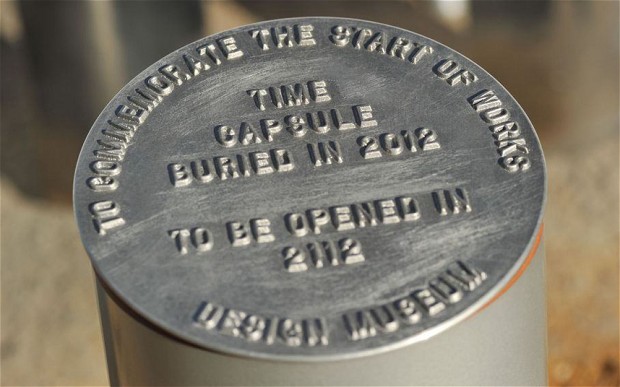
Time Capsules: Buried Reminders for Future Discovery
|
Share This Page
|
|
|
|
|
|
|
Follow This Site

|
 |
|
|
|
|

|
Time Capsules are snapshots of days gone by.
Most time capsules are collections of items that are buried underground, likely in a container to protect the contents, with instructions to open the time capsule on a certain date. Common intervals are anniversaries like 50 years or 100 years. (Some extreme examples project far into the future.)
Time capsules can be personal or general, tiny or gigantic. They are limited only by the imagination of the people who create them. They can also be variable in their durability, depending on the care taken in preparing the capsule (not to mention the material used). Many time capsules are not retrieved because people move on or just forget about them.
 One of the earliest known time capsules is the Crypt of Civilization, a sealed airtight stone chamber at Oglethorpe University, in Brookhaven, Ga. The brainchild of Thornwell Jacobs, the Crypt was sealed in 1936 and is intended to be opened in the year 8113. One of the earliest known time capsules is the Crypt of Civilization, a sealed airtight stone chamber at Oglethorpe University, in Brookhaven, Ga. The brainchild of Thornwell Jacobs, the Crypt was sealed in 1936 and is intended to be opened in the year 8113.
The interior of the chamber is intended to look like a room in an Egyptian pyramid. Items stored in the Crypt are sealed in airtight receptacles, lined with glass and filled with an inert gas.
Among the contents are these:
- paper and microfilm copies of more than 800 classic works of literature (along with microfilm readers and projectors)
- an original copy of the script for the iconic American movie Gone With the Wind
- voice recordings of historial figures such as Franklin D. Roosevelt, Joseph Stalin, Adolf Hitler, and Benito Mussolini
- small machines such as a radio, a typewriter, and an adding machine
- plastic toys representing children's favorites Donald Duck and the Lone Ranger.
Oglethorpe University is also home to the International Time Capsule Society, which aims to have a complete record of all known time capsules.
Among the publicized physically buried time capsules are these:
 The National Millenium Time Capsule, buried in 2000 in Washington, D.C., is scheduled to be opened in 2100. Said to be included are several important objects from history, including a WWII helmet, a piece of the Berlin Wall, a mobile phone, the trumpet of famed jazz artist Louis Armstrong, and a Twinkie. The National Millenium Time Capsule, buried in 2000 in Washington, D.C., is scheduled to be opened in 2100. Said to be included are several important objects from history, including a WWII helmet, a piece of the Berlin Wall, a mobile phone, the trumpet of famed jazz artist Louis Armstrong, and a Twinkie.- Residents of Seward, Nebraska, created what they say is the world's largest time capsule, a 45-ton vault, in 1975. Inside are a Chevy Vega car, a large amoutn of 1970s clothing, and more than 5,000 other items. The vault is meant to be opened on July 4, 2025.
- Perhaps the most far-reaching time capsules yet known are two buried at World's Fairs in New York, in 1939 and 1964. Containing microfilm, news reels, an electronic watch, an electronic toothbrush, and other items of interest, the two time capsules are meant to be opened in 6939.
The desire to preserve things and thoughts has reached the virtual world as well. Online sites designed to help people create a digital time capsule are widespread. |
|